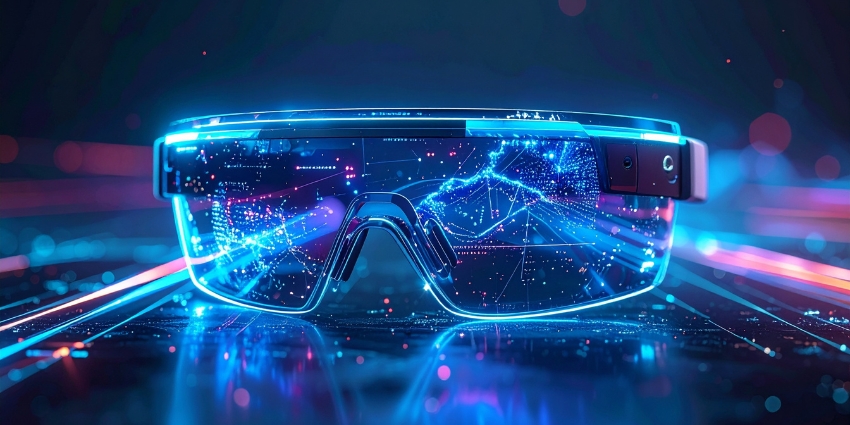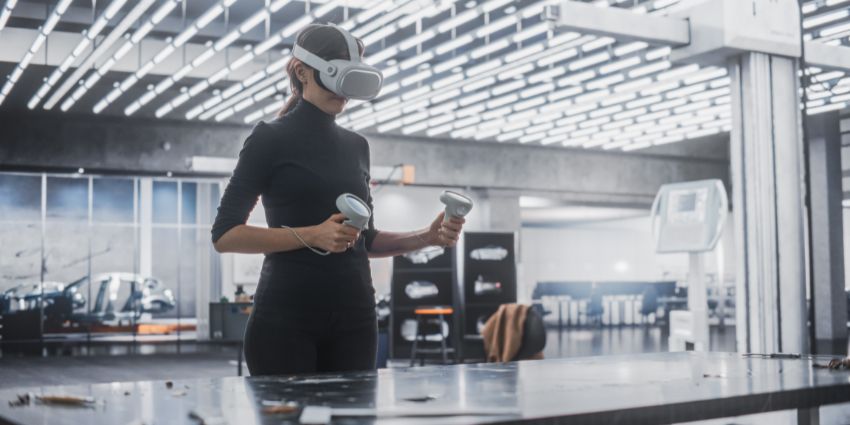The compressor is whining, the client is waiting, and your senior specialist is three time zones away. A field engineer slips on augmented reality smart glasses, starts a live share, and the expert sees exactly what they see. A quick annotation floats into view, the fix lands on the first try, and the site is back online before anyone writes up a ticket. That is the everyday promise of AR smart glasses when they’re treated as a serious endpoint in your unified communications stack.
In 2026, this category is going to be bigger than ever. AI smart glasses alone could be worth $3.01 billion by 2032, and shipments of XR tech to enterprise companies have been accelerating.
What should business leaders care about? Hands-free collaboration in noisy, high-stakes environments. Faster training and fewer errors on the floor. Clearer customer moments without juggling screens. It’s all possible with the right smart glasses for business.
The Turning Point for AR Smart Glasses in Business
2025 has become a landmark year for immersive technology.
The arrival of Samsung’s Galaxy XR platform, along with Google and Samsung’s upcoming AR smart glasses, shows how far usability has come. These new models are lighter, faster, and designed to hand most of the heavy processing off to the phone, linking mobile devices, collaboration tools, and spatial data into one smooth experience.
Edge computing and on-device AI now translate speech, identify parts, and surface workflow instructions in real time.
Across industries, more companies are picking up smart glasses from names like Meta and Varjo to simplify communication and staff training within their current systems. Compatibility with Teams, Zoom, and Webex now tops most procurement lists.
Even Apple seems ready to join the race, preparing business-ready wearables such as Vision Air, and possibly its own line of enterprise glasses. When tech leaders all start building on the same extended-reality foundation, it’s a clear sign that augmented reality benefits have moved out of the testing lab and into the boardroom.
6 Business-Driven Benefits of Augmented Reality Smart Glasses
The value of augmented reality smart glasses is becoming more obvious. Across logistics floors, design studios, and customer sites, they’re proving what the hype couldn’t: measurable augmented reality benefits that make work faster, safer, and more connected.
Operational Efficiency and Cost Reduction
One of the main reasons companies have been reluctant to invest in augmented reality smart glasses and XR solutions in recent years is the cost. Leveraging the latest XR tech can be expensive. Even Apple’s spatial computing solution costs almost $4,000.
AR smart glasses, however, are a much more affordable way to enter the metaverse and unlock the power of immersion. They’re also excellent for reducing various operational and business costs.
Time and travel are expensive. Smart glasses for businesses are cutting both. At DHL, deploying Vuzix head-mounted displays boosted warehouse picking efficiency by 25 percent and reduced error rates dramatically.
In automotive plants, Vuzix and NSFlow report maintenance teams completing line-side inspections without ever leaving the work zone. Field service companies using Samsung’s Galaxy XR platform say average repair times dropped 30 to 40 percent once technicians could share what they saw instead of describing it.
That’s the hidden power of augmented reality smart glasses; they merge remote collaboration with frontline execution. Engineers can receive live guidance from experts, hands-free, through familiar UC tools like Teams or Webex.
Enhanced Collaboration and Communication
Communication gaps kill productivity. AR smart glasses close them by turning real-time context into a shared experience.
A hybrid manager can see a factory floor through a technician’s lens and annotate equipment live. Remote translators can render instructions in view as speech flows between languages. Meta’s Ray-Ban Display glasses already project captions, messages, and even navigation cues into the wearer’s line of sight.
AR smart glasses are emerging as “the third interface”, not replacing phones or laptops, but freeing workers from constant screen juggling. Accessibility is becoming a key reason companies are adopting AR smart glasses, too. Tools like voice control, captioning, and instant translation let every team member take part without extra effort.
For people spread across offices and time zones, that kind of hands-free connection feels easy, natural, and refreshingly human.
Innovation, Design, and Faster Time-to-Market
In design and engineering, speed is everything. Augmented reality smart glasses bring 3D prototypes, blueprints, and digital twins into the wearer’s field of view.
Teams using XREAL One Pro glasses can overlay CAD models side-by-side, spotting issues before production. Automotive engineers leveraging Vuzix devices review schematics and perform quality checks in situ, saving rework time.
The newest glasses use AI to keep digital visuals aligned as the wearer moves. Designs stay in place, updates appear instantly, and the workflow feels natural. That kind of precision saves hours in redesigns and approvals. In industries where time equals money, it can easily set one company ahead of another.
Productivity and Employee Performance
When information moves into a worker’s line of sight, productivity surges. AREA research cited by Business.com found that AR-guided workflows cut failure rates by 70 percent, rework by 80 percent, and increase procedure speed by 40 percent.
Frontline staff using augmented smart glasses can access digital checklists, capture photos, and call supervisors without breaking focus. As hardware evolves: Samsung’s Galaxy XR headset, Meta’s Ray-Ban Display, and the coming Apple Vision Air, battery life, connectivity, and comfort are eliminating the last barriers.
In every case, the message is the same: keep workers informed without pulling them away from the task, and performance follows.
Customer Experience and Engagement
Customer expectations have evolved. They want instant answers and visual clarity. Smart glasses for businesses make that possible without adding friction.
Imagine a sales rep walking a client through a complex setup using live AR annotations, or a support technician showing a remote customer exactly which part to adjust. Retailers adopting AR visualization tools see remarkable results. REYDAR reports that 3D and AR product views can raise online conversion rates by 94 percent.
In-person interactions are improving, too. Meta’s Ray-Ban Display glasses display live captions or translations during meetings, removing communication barriers.
For customer-facing teams, the augmented reality benefits are clear: more engaging demonstrations, fewer misunderstandings, and faster paths to “yes.”
Training, Skills Transfer, and Workforce Development
Every organization faces a training bottleneck. Augmented reality smart glasses break it.
By overlaying digital instructions and live mentor guidance, new hires learn procedures hands-on, not from a manual. PwC’s study on immersive learning famously found that participants trained with AR/VR finished up to four times faster and retained knowledge better.
In manufacturing and healthcare, Vuzix and Nsflow deployments let experts train multiple employees remotely, seeing what each trainee sees in real time. The approach scales institutional knowledge without the cost or downtime of classroom sessions. With augmented reality smart glasses, training becomes a real experience, learning happens on the job, not in a classroom, and mistakes drop before they ever reach the customer.
Implementing Augmented Reality Smart Glasses for Business
Rolling out augmented reality smart glasses is about building trust, proving the value fast, and making the tech feel as natural as checking your email. The businesses getting this right are approaching it like any other transformation project, with small steps, clear goals, and an obsession with measurement.
- Start small and define success: Choose one issue that eats up time or budget: extra travel, onboarding delays, or warehouse errors. Set measurable goals such as fewer repeat visits or faster task completion.
- Work within existing tools: Keep the process familiar. Modern AR smart glasses connect directly to Teams, Zoom, or Webex, so technicians can share live video or capture records without stopping their work.
- Run a focused pilot, not a science project: Start with ten to twenty devices in one team. Keep the loop tight: test, gather feedback, fix pain points, repeat. Vodafone Business calls this “proof of everyday value.”
- Train, then listen: Even the most intuitive hardware still needs context. A one-hour orientation and a short cheat-sheet often do more than a glossy manual. Early champions, those who actually enjoy using the glasses, become your best internal trainers.
To see lasting results, track progress from day one. The strongest augmented reality benefits come when teams measure what’s working, learn from real data, and use those insights to refine each new rollout.
The Real-World Challenges You’ll Want to Tackle Early
No rollout happens without hiccups, so it pays to handle common issues early.
- Security and control: Manage glasses through your existing device systems, with remote wipe and app permissions built in. Clear privacy policies are vital for regulated fields.
- Accessibility and comfort: Adjust brightness, captions, and voice tools so everyone can use them confidently: an “augmented equality” approach that makes adoption smoother.
- Hardware fit: Compare weight, battery life, and connectivity instead of just chasing big names. Take the time to find what fits your teams.
- Expectation management: The technology is maturing fast, but success depends as much on change management as it does on silicon.
The winning approach stays simple: start small, integrate well, measure often, and celebrate the wins that matter.
The Road Ahead for Augmented Reality Smart Glasses
For a long stretch, augmented reality smart glasses felt like an idea waiting on better hardware. That wait ended in 2025, when the technology finally met the promise: lighter, faster, and ready for real work.
The major players aren’t testing ideas; they’re building platforms. Meta’s latest Ray-Ban Display glasses, Samsung’s Galaxy XR with Google, and Apple’s upcoming Vision Air show how quickly these devices are blending into daily work.
Vendors are even starting to bundle smart glasses for businesses as subscription services, packaging hardware, software, and analytics under one predictable cost. That makes budgeting easier and gives companies constant access to upgrades.
2026 and 2027 will be the years when this category tips into the mainstream. The companies experimenting now will already have their playbooks written and their teams fluent in the tools.
For anyone leading a workforce, the next step is clear: run the pilot, gather the data, and make smart glasses for businesses part of your unified communications plan. The organizations that do will discover the deeper augmented reality benefits first, and wonder how they ever worked without them.







